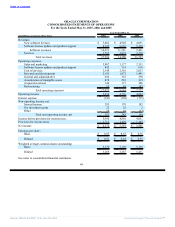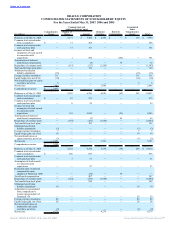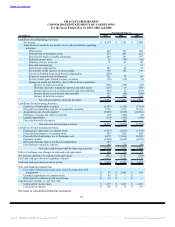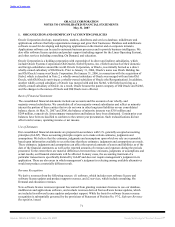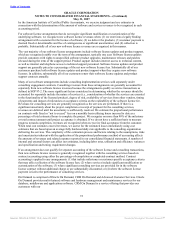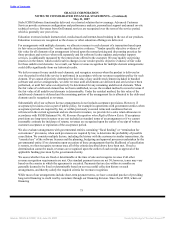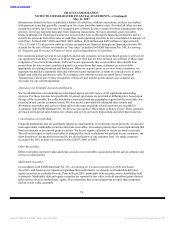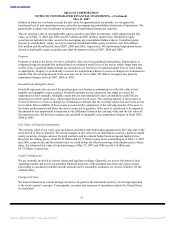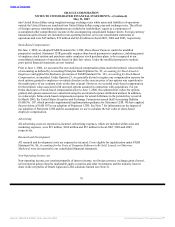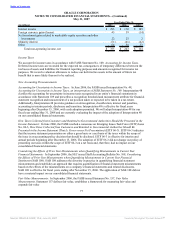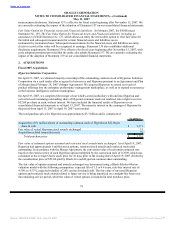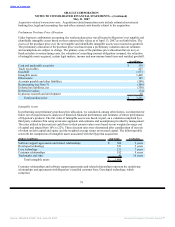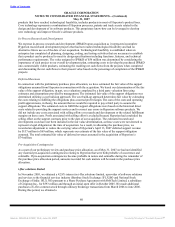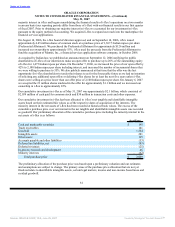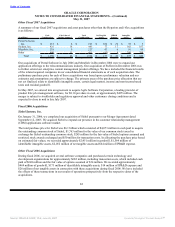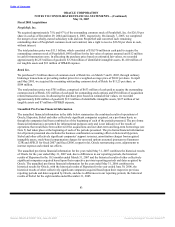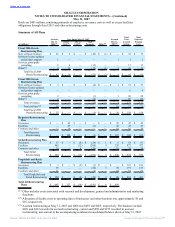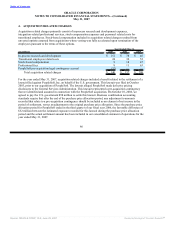Oracle 2006 Annual Report Download - page 83
Download and view the complete annual report
Please find page 83 of the 2006 Oracle annual report below. You can navigate through the pages in the report by either clicking on the pages listed below, or by using the keyword search tool below to find specific information within the annual report.
Table of Contents
ORACLE CORPORATION
NOTES TO CONSOLIDATED FINANCIAL STATEMENTS—(Continued)
May 31, 2007
Year Ended May 31,
(in millions) 2007 2006 2005
Interest income $ 295 $ 170 $ 185
Foreign currency gains (losses) 45 39 (14)
Net investment gains related to marketable equity securities and other
investments 22 25 2
Minority interest (71) (41) (42)
Other 64 50 33
Total non-operating income, net $ 355 $ 243 $ 164
Income Taxes
We account for income taxes in accordance with FASB Statement No. 109, Accounting for Income Taxes.
Deferred income taxes are recorded for the expected tax consequences of temporary differences between the
tax bases of assets and liabilities for financial reporting purposes and amounts recognized for income tax
purposes. We record a valuation allowance to reduce our deferred tax assets to the amount of future tax
benefit that is more likely than not to be realized.
New Accounting Pronouncements
Accounting for Uncertainty in Income Taxes: In June 2006, the FASB issued Interpretation No. 48,
Accounting for Uncertainty in Income Taxes, an interpretation of FASB Statement No. 109. Interpretation 48
clarifies the accounting for uncertainty in income taxes recognized in an entity’s financial statements in
accordance with Statement 109 and prescribes a recognition threshold and measurement attribute for financial
statement recognition and measurement of a tax position taken or expected to be taken in a tax return.
Additionally, Interpretation 48 provides guidance on derecognition, classification, interest and penalties,
accounting in interim periods, disclosure and transition. Interpretation 48 is effective for fiscal years
beginning after December 15, 2006, with early adoption permitted. We will adopt Interpretation 48 for our
fiscal year ending May 31, 2008 and are currently evaluating the impact of the adoption of Interpretation 48
on our consolidated financial statements.
How Taxes Collected from Customers and Remitted to Governmental Authorities Should Be Presented in the
Income Statement: In June 2006, the FASB reached a consensus on Emerging Issues Task Force (EITF) Issue
No. 06-3, How Taxes Collected from Customers and Remitted to Governmental Authorities Should Be
Presented in the Income Statement (That Is, Gross versus Net Presentation) (EITF 06-3). EITF 06-3 indicates
that the income statement presentation on either a gross basis or a net basis of the taxes within the scope of
the issue is an accounting policy decision that should be disclosed. EITF 06-3 is effective for interim and
annual periods beginning after December 15, 2006. The adoption of EITF 06-3 did not change our policy of
presenting our taxes within the scope of EITF 06-3 on a net basis and, therefore, had no impact on our
consolidated financial statements.
Considering the Effects of Prior Year Misstatements when Quantifying Misstatements in Current Year
Financial Statements: In September 2006, the SEC issued Staff Accounting Bulletin No. 108, Considering
the Effects of Prior Year Misstatements when Quantifying Misstatements in Current Year Financial
Statements (SAB 108). SAB 108 addresses the diversity in practice in quantifying financial statement
misstatements and establishes an approach that requires quantification of financial statement misstatements
based on the effects of the misstatements on a company’s financial statements and related disclosures.
SAB 108 is effective for fiscal years ending after November 15, 2006. The application of SAB 108 did not
have a material impact on our consolidated financial statements.
Fair Value Measurements: In September 2006, the FASB issued Statement No. 157, Fair Value
Measurements. Statement 157 defines fair value, establishes a framework for measuring fair value and
expands fair value
77
Source: ORACLE CORP, 10-K, June 29, 2007 Powered by Morningstar® Document Research℠


